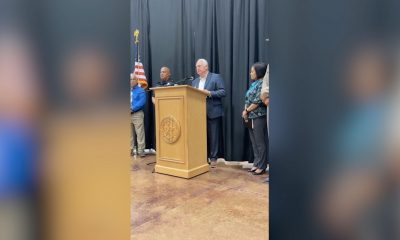Planning for retirement requires careful financial management, yet many people overlook warning signs that could lead to financial hardship in their later years. Whether it’s overspending, lack of planning, or ignoring key savings strategies, these behaviors can spell trouble for retirement. Recognizing these red flags early allows for course correction and a more secure financial future. Here are 20 clear red flags of someone headed for a penniless retirement.
No Retirement Savings Plan

Shutterstock
One of the biggest warning signs is not having any structured plan for retirement savings. Without a 401(k), IRA, or other savings vehicle, it’s nearly impossible to build the wealth needed for a comfortable retirement. Starting early and contributing consistently is essential. Ignoring this step leads directly to financial insecurity in later years.
Living Paycheck to Paycheck

Shutterstock
Those who spend every dollar they earn without saving anything for the future are at significant risk. Living paycheck to paycheck leaves no room for building an emergency fund or retirement nest egg. Breaking this cycle requires budgeting and prioritizing savings. Failing to do so makes financial independence in retirement unlikely.
Relying Solely on Social Security

Shutterstock
Social Security was designed to supplement retirement income, not serve as the sole source. Relying only on these benefits often leads to a retirement marked by financial struggle. Diversifying income streams, such as pensions, savings, and investments, is critical for financial security in retirement.
No Emergency Fund

Shutterstock
Without an emergency fund, unexpected expenses can quickly derail financial stability. Medical bills, home repairs, or other emergencies can lead to debt and reduced retirement savings. Building an emergency fund should be a priority for anyone planning for a secure future.
High Credit Card Debt

Shutterstock
Carrying significant credit card debt into retirement is a major red flag. Interest payments can eat into fixed incomes, leaving little for daily expenses or savings. Paying down high-interest debt before retirement is crucial to avoid financial strain later in life.
Not Tracking Spending

Shutterstock
Failing to monitor spending habits often leads to overspending and an inability to save. Many people underestimate how much they spend on discretionary items, leaving less for retirement contributions. Budgeting tools and apps can help keep finances on track and identify areas to cut back.
Not Taking Advantage of Employer Match Programs

Shutterstock
Many employers offer 401(k) matching contributions, essentially free money for retirement savings. Failing to contribute enough to receive the full match is a missed opportunity. Taking advantage of these programs is one of the simplest ways to build a retirement fund efficiently.
Overspending on Housing

Shutterstock
Spending too much on housing can leave little room for retirement savings. High rent or mortgage payments that exceed 30% of income create long-term financial stress. Downsizing or relocating to a more affordable area can free up funds for saving and investing.
Ignoring Health Costs

Shutterstock
Healthcare is one of the most significant expenses for retirees. Failing to plan for medical costs, including insurance and long-term care, can quickly drain retirement savings. Investing in a Health Savings Account (HSA) or similar plans can help offset these costs in the future.
Postponing Retirement Contributions

Shutterstock
Many people delay contributing to retirement accounts, thinking they’ll have time to catch up later. Unfortunately, time is one of the most valuable assets for building wealth through compound interest. Starting early and contributing consistently is the best strategy for a secure retirement.
They Don’t Have a Budget

Shutterstock
Living without a budget means money often slips through the cracks, leaving less for retirement savings. Without tracking income and expenses, it’s difficult to identify areas where cuts can be made. Creating a realistic budget helps ensure financial goals, including retirement savings, are met.
They Don’t Have a Backup Plan

Shutterstock
Relying on a single income source for retirement, such as Social Security or a pension, is risky. Economic downturns, job loss, or benefit reductions can derail plans. A diversified income strategy, including investments, part-time work, or rental income, provides financial stability in retirement.
They Frequently Dip Into Savings

Shutterstock
Regularly withdrawing from savings for non-emergency expenses reduces the funds available for retirement. This habit undermines long-term financial goals and the power of compound interest. Building an emergency fund for unexpected expenses can help protect retirement savings from unnecessary depletion.
They Don’t Adjust for Inflation

Shutterstock
Failing to account for inflation when planning for retirement can result in underestimating future expenses. Inflation gradually erodes purchasing power, making retirement savings worth less over time. Investing in assets that outpace inflation, such as stocks or real estate, can help protect retirement funds.
They Lack Financial Education

Shutterstock
Many people headed for financial trouble in retirement lack basic knowledge about saving, investing, or managing money. This knowledge gap often leads to poor financial decisions. Seeking advice from financial advisors, reading personal finance books, or taking online courses can help bridge the gap and improve outcomes.
They Depend Too Much on Credit

Shutterstock
Overusing credit cards to cover daily expenses is a major red flag. High-interest debt often becomes unmanageable and limits the ability to save for retirement. Paying off debt and living within one’s means are essential steps toward achieving financial freedom in retirement.
They Don’t Maximize Tax Benefits

Shutterstock
Failing to take advantage of tax benefits, such as contributing to tax-deferred retirement accounts, can leave money on the table. Roth IRAs, 401(k)s, and HSAs offer significant tax advantages that can grow savings faster. Working with a financial planner can ensure these opportunities aren’t overlooked.
They Don’t Discuss Finances with Their Partner

Shutterstock
Lack of communication about finances in a partnership can lead to misunderstandings and poor financial planning. Couples who don’t align their retirement goals often fall short of their savings targets. Regular discussions about spending, saving, and retirement planning can prevent financial surprises later on.
They Haven’t Paid Off Their Mortgage

Shutterstock
Carrying a mortgage into retirement can strain fixed incomes and limit financial flexibility. Paying off the mortgage before retiring eliminates a significant monthly expense. Downsizing to a smaller, more affordable home is another option for reducing housing costs in retirement.
They Don’t Have a Retirement Timeline

Shutterstock
Failing to set a clear retirement timeline often leads to procrastination and inadequate preparation. Without a target date, it’s challenging to determine how much to save and how long to work. Establishing a retirement age and savings goal creates a roadmap for achieving financial security.
Conclusion

Shutterstock
Avoiding a penniless retirement requires recognizing these red flags and taking proactive steps to address them. Financial security in later years depends on careful planning, disciplined saving, and smart spending habits. By making small changes now, it’s possible to build a comfortable and worry-free retirement. The earlier you start, the better prepared you’ll be for the future.





















































